
The Strength Moves Every Runner Should Be Doing

Posted on 16 May, 2022

Runners love to run. A crazy concept, right? And runners almost always only want to run. It’s hard enough to fit the daily miles into our schedule, so how can we possibly make time for “extra” strength training on top of that? Isn’t running enough?
Sadly, it's not. Runners are a frequently injured group. Some statistics put runners' annual injury rate as high as 66 percent! The problem is that many of us live mostly sedentary lives, so our bodies aren’t always prepared to handle the stress of pounding the pavement. Plus with an already overflowing schedule, many of us think we simply don’t have time to add strength training to our regimen.
But here’s the good news: Even a small amount of regular strength training improves your structural fitness, which is the ability of your bones, ligaments, tendons, and muscles to support you and stay healthy while running. Several studies show that building hip strength is critical for injury prevention , and it doesn't take a lot. A mere 15 to 20 minutes of running-specific strength work twice a week can dramatically cut your risk for running injuries.
The following routine focuses on hip strength and will only take 20 minutes, max. Make the exercises easier or harder based on your ability level: Decrease the number of reps or time interval if any exercises feel too tough, or hold medium-weight dumbbells during the lunges, step-ups, squats, and deadlifts if you’re looking for a greater challenge.
Work your way through the moves in order, then repeat for a second set. Try to do it right after finishing your run, while your muscles are still loose and warm. Adding this workout to your running routine just two days a week will help keep you off the sidelines and going strong in the long run (see what we did there?).
These five types of lunges move your body in various planes of motion, working your body in different ways. For each type, start with 2 reps per leg in each set, and as you grow stronger with time, progress to 5 reps per leg.
1. Forward Lunge
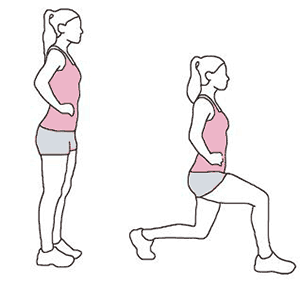 The classic lunge strengthens your quads, hamstrings, and glutes, and helps increase the range of motion of the hip flexor. Since most of have tight hip flexors from sitting most of the day, this is a great exercise specific to efficient running form.
The classic lunge strengthens your quads, hamstrings, and glutes, and helps increase the range of motion of the hip flexor. Since most of have tight hip flexors from sitting most of the day, this is a great exercise specific to efficient running form.
How to: Take a step forward with your right leg so your knee is positioned over your ankle. Lower your body until your left knee brushes the ground. Step back and repeat on the other side.
2. Twisting Lunge
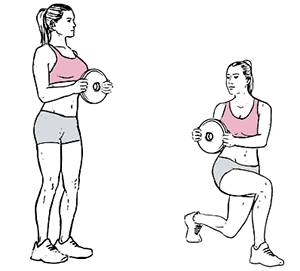 The twisting lunge helps engage the core because it requires balance and a sense of proprioception (knowing how your body is positioned).
The twisting lunge helps engage the core because it requires balance and a sense of proprioception (knowing how your body is positioned).
How to: Perform a forward lunge, but rotate your torso to the same side that you lunge forward with. (If you lunge forward on your right leg, twist your torso to the right as well.) Step back and repeat on the other side.
3. Lateral Lunge
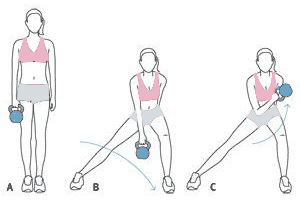 Also known as a side lunge, this move activates the abductors and hip-stabilizing muscles more than a forward lunge.
Also known as a side lunge, this move activates the abductors and hip-stabilizing muscles more than a forward lunge.
How to: Step out to your right side, keeping both feet pointing ahead of you. Lower your body until your right thigh is about parallel to the ground, keeping your left leg is straight. Step back to center and repeat on the other side.
4. Diagonal Lunge
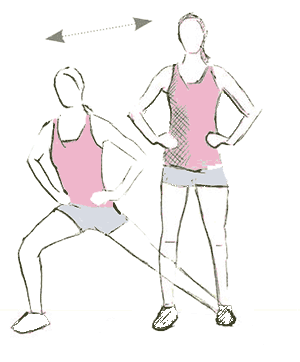 Stepping out at a diagonal forces your body to move in two different planes of motion (frontal and sagittal), preparing the body for the rotational demands of running.
Stepping out at a diagonal forces your body to move in two different planes of motion (frontal and sagittal), preparing the body for the rotational demands of running.
How to: Stand with your feet hip-width apart. Just like you would with a traditional lunge, take a large step forward with your right leg, but instead of moving in a straight line, step out on a diagonal. Bend both knees until your right knee forms about a 90-degree angle. Step back and repeat on the other side.
5. Reverse Lunge
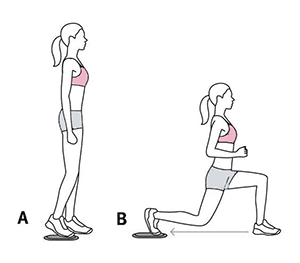 This is often the most challenging type of lunge since it requires more balance, recruits the glutes, and involves more of a hip extension.
This is often the most challenging type of lunge since it requires more balance, recruits the glutes, and involves more of a hip extension.
How to: Take a step back with your right leg and lower your body until your right thigh is about parallel to the ground and your left knee brushes the ground. Keep your toes pointing straight ahead. Step back and repeat on the other side.
6. Step-Up
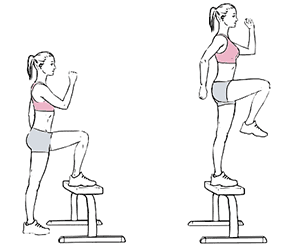 Step-ups fire up your quads as they work to straighten your leg, and they also strengthen your hamstrings and glutes.
Step-ups fire up your quads as they work to straighten your leg, and they also strengthen your hamstrings and glutes.
How to: Stand in front of a step or bench one to two feet high. Step up with your right foot until your leg is straight. Maintain a tall posture and step down with the left foot. Repeat on the other side.
7. Pistol Squat
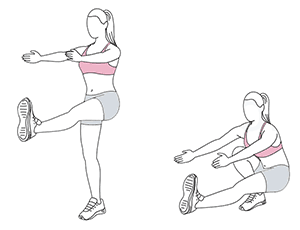 This move is crucial for runners because it's a single-leg exercise. Running is essentially a series of very coordinated one-legged hops, so pistol squats are specific to the demands of running and help prevent assymetrical imbalances.
This move is crucial for runners because it's a single-leg exercise. Running is essentially a series of very coordinated one-legged hops, so pistol squats are specific to the demands of running and help prevent assymetrical imbalances.
How to: Stand on your right leg with your arms straight out in front of you, then slowly squat down so your right thigh is almost parallel to the ground. Keep the motion slow and controlled, then return to standing. Repeat on the other side.
8. Single-Leg Deadlift
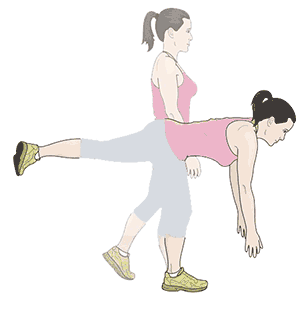 Deadlifts focus on glute and hamstring strength, two often neglected muscles that are critical for stabilization and power while running. These muscles also tend to be weaker in runners who live sedentary lives, so it's even more critical to strengthen them if you sit most of the day.
Deadlifts focus on glute and hamstring strength, two often neglected muscles that are critical for stabilization and power while running. These muscles also tend to be weaker in runners who live sedentary lives, so it's even more critical to strengthen them if you sit most of the day.
How to: Stand up straight, then bend forward from the hip (not the spine) while standing on your left leg and extending your right leg behind you for balance. Return to standing by activating the glutes.
9. Push-Up
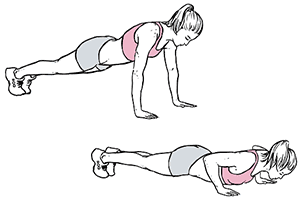 Don't neglect upper-body strength! The classic push-up contributes to core strength, which helps build a better foundation for running.
Don't neglect upper-body strength! The classic push-up contributes to core strength, which helps build a better foundation for running.
How to: From plank position with your hands shoulder-width apart, lower your body until your chest reaches the ground. Push back up. To modify, rest your weight on your knees instead of your toes.
10. Marching Bridge
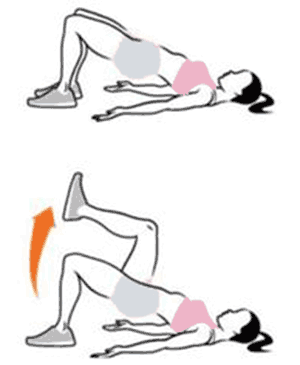 This exercise focuses almost exclusively on hip stability, which is critical for keeping the entire leg stable during each stride, and glute strength, which provides strength and power during the stride and helps maintain good posture.
This exercise focuses almost exclusively on hip stability, which is critical for keeping the entire leg stable during each stride, and glute strength, which provides strength and power during the stride and helps maintain good posture.
How to: Lie faceup with your feet flat on the ground. Lift your hips by driving your heels into the ground and contracting your glutes so you form a straight line from your shoulders to your knees. Straighten one leg, hold for 2 to 3 seconds, and repeat on the other side. Make sure your hips stay level and your rear doesn’t sag toward the ground.
11. Plank
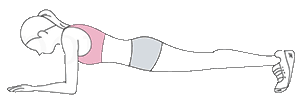 The abdominal and oblique muscles worked in this move help maintain a neutral pelvis while running, which is beneficial for injury prevention.
The abdominal and oblique muscles worked in this move help maintain a neutral pelvis while running, which is beneficial for injury prevention.
How to: Place the forearms on the ground with the elbows aligned below shoulders and arms parallel to the body about shoulder-width apart. Hold. If flat palms bother your wrists, clasp your hands together.
Strength Conditioning For Runners

by Peter Magill

by Jay Dicharry

by Kelly Starrett

by Jeff Horowitz
 Spectator Placards That Will Get You Running Faster
Spectator Placards That Will Get You Running Faster The Dark Side Of Running
The Dark Side Of Running 30 Convincing Reasons To Start Running Now
30 Convincing Reasons To Start Running Now 25 Runners Share the Biggest Mistakes They Made as Beginners
25 Runners Share the Biggest Mistakes They Made as Beginners










